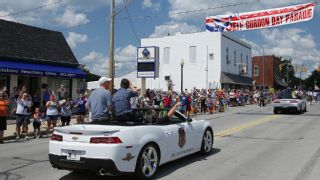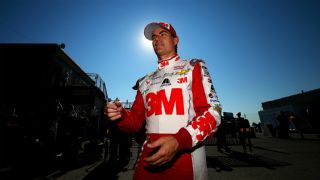|
INDIANAPOLIS -- Just two victories into a career that ranks third all time in the NASCAR Sprint Cup Series -- and before he had even won his first of four series championships -- Jeff Gordon could have retired a happy man. If he had turned in his firesuit and helmet after his victory at the inaugural Brickyard 400 on Aug. 6, 1994, Gordon would have looked back on a NASCAR career marked by a historical and magical highlight that would make him smile and gush with pride. At 23 years and 2 days old, Gordon accomplished a lifelong dream to win at Indianapolis Motor Speedway. "That was the ultimate," Gordon said Thursday, nearly 21 years later. "It could have all ended that day. It would have been fine with me." The connection of Gordon to Indiana didn't start with childbirth. It started at around age 12 or 13 when he began coming to race in the state, where rules allowed for drivers to race higher horsepower cars at a younger age than in his home state of California. After his freshman year in high school in Vallejo, California, Gordon and his family moved briefly to Ohio before settling in Pittsboro, Indiana, a little community with a population of about 850 tucked amid the farmland 20 minutes from the Indianapolis Motor Speedway. His family's goal: get him ready to race at IMS. Back in 1986, the 14-year-old Gordon had his sights set on the Indianapolis 500 and on acclimating to life in Indiana. He left the break-dancing in California and tried to learn to play basketball, a requirement of any Indiana schoolkid. He'd play on the upper level of a barn, clearing the hay and having to shoot over the rafters. Needless to say, Gordon was a better race car driver than basketball player. Every Friday, Saturday and Sunday, he would go race, again with his eyes on the palace of speed at 16th and Georgetown. "When you race around here, it doesn't matter [it it's] midgets, USAC or local sprint cars. Every guy out there wants to go race at the Indy 500," Gordon said. "They're getting in rides any which way they can, and a few of the guys that I was racing with -- like Rich Vogler, Andy Hillenburg -- these guys got some chances, but it wasn't realistic they were going to happen for anybody." So Gordon's family made a decision. He would stop chasing his Indianapolis 500 dream and go with the more realistic one -- a career in this growing stock car circuit called NASCAR. Eventually that would lead him back to Indianapolis to race, including that hometown hero of a victory in 1994 that proved that stock car racing in open-wheel's mecca wasn't as sacrilegious as everyone thought. "When that [Indy 500 ride] looked like it wasn't going to happen, I went and raced NASCAR," Gordon said. "I love NASCAR. It was meant for me. I really believe that because I am more of an oval racer. I would have never made it in Indy cars, in my opinion." Gordon returns to Indianapolis Motor Speedway for what is expected to be his last race at the 2.5-mile track that many consider hallowed grounds. He will compete in the Crown Royal 400 on Sunday in his final full season of a career that has included 92 victories -- five at Indianapolis. Ever since Gordon announced in January that he would retire from full-time racing after this season, ticket sales for the Brickyard have trended higher than a year ago. The track centered its marketing campaign around Gordon's last ride, including having him drive the pace car prior to the Indianapolis 500 in May.  If anything during this retirement season nears a spiritual experience, it will occur Sunday for Gordon when he flips the ignition switch for the 22nd and final time at IMS -- his dreams of racing at Indianapolis fulfilled, but soon to be over in a career nothing like he could imagine. "It seems like it's just been a blur," Gordon said Thursday in Pittsboro, which honored him with a parade (he already had a road named after him). "It's amazing. "You go to a racetrack just hoping that you can win that race, and the next thing you know you've won five Brickyard 400s and four championships, and you're coming back and they're having a day named after you and a parade." Gordon's impact in this area and in NASCAR runs deep. When Gordon suddenly turned into a NASCAR star, winning his first championship by age 24 and his third at 27, every team went looking for the next Jeff Gordon. Joe Gibbs Racing found its Jeff Gordon in a fiery Indy Racing League driver named Tony Stewart. If Hendrick Motorsports had a sprint-car-turned-stock-car phenom, JGR could have one, too. "Jeff Gordon was probably the biggest influence [in my move]," Stewart said. "He had a lot of success in USAC -- won a lot of races. He wasn't just handed an opportunity in NASCAR. He earned his way down there. When he got the opportunity to go to NASCAR, he opened up a lot of opportunities for drivers like myself. "And the TV package that USAC had at the time with the Thursday Night Thunder series on ESPN, it brought guys from all over the country because of the recognition that could be earned from running USAC." Several others followed, including some in Sunday's lineup such as former USAC stars Stewart, Ryan Newman, Kyle Larson, Ricky Stenhouse Jr., Justin Allgaier, Josh Wise and J.J. Yeley. Other IndyCar stars such as Sam Hornish Jr. and Danica Patrick also made the transition. Newman, Allgaier, Hornish and Patrick have Midwestern roots. Larson, Wise and Yeley hail from the West Coast. All felt the influence of Gordon. "We had guys coming from Pennsylvania, California, Colorado, Wisconsin and Illinois to participate in USAC races because of Jeff's success and the opportunity that he had to come to NASCAR," Stewart said. "Indy cars weren't an option at the time because, unless you brought a big-dollar sponsor, you weren't going to get a ride." All that history, all that influence, all those roots will be on display when Gordon takes the green flag Sunday afternoon. He hasn't had the best of years -- he sits 10th in the Sprint Cup standings -- but he enters the race as its defending champion and the fan favorite -- and possibly even the nonfan sentimental favorite. When he returned Thursday to Pittsboro for the first time in about a decade, the memories flowed as his friends pointed out individuals amid the crowd who helped groom Gordon. His teachers were lenient with a kid who traveled to little towns across the country to race each weekend. They continue to cheer for him and he remains one of their own, even if he doesn't get back to the town that often.  Part of the affection stems from Hoosier hospitality and part of it comes from a deep-rooted Indy reverence for anyone who can amaze and excite with what they do behind the wheel of a race car. Unless you're a famous basketball coach a la Bobby Knight or John Wooden, or an Indiana legend high school player such as Bobby Plump, you're most likely going to be revered if you can come to Indianapolis and win a race. "Had we not won [at Indy] last year, I would say there would be more pressure," Gordon said after the Pittsboro parade. "But I'm more and more motivated by this type of event and excitement more than anything else. "You can't take away what this speedway, and what this town and state, has meant to me, no matter what happens on Sunday. That just is the icing on the cake and the ultimate experience if you can pull it off." With a new aerodynamic package designed to increase drag to promote more drafting and slingshot passing, Gordon has no clue how the race will play out. He knows it takes close to a perfect race to win at Indianapolis. Still, he'll take the unknown just to be able to start his engine at IMS. Gordon remembers when nine drivers participated in a Goodyear tire test at the track in June 1992. Gordon had won a couple of Xfinity Series races and was clearly on a path to race in Cup. "I didn't get invited to the test and I was pretty bummed out about that," Gordon said. "At the time, it was just an exhibition. They didn't know whether it really was going to happen. "But shortly after that, I'm in Cup and they announce it. I was like, 'Wow, that is the coolest announcement that I've ever heard, that I finally get to race at Indianapolis Motor Speedway.'" It was the first of many cool NASCAR moments for Gordon at the Brickyard. A lot has changed since then. Pittsboro has swelled to 3,000 people. The site of Frank and Mary's Tavern, a catfish restaurant, now is home to a Dollar General. Gordon has evolved from a self-described Pittsboro kid -- "just doing silly, stupid things that you do when you're out in the country and driving to school in the snow, get stuck in the snow and going to the racetrack" -- into a racing superstar and an international philanthropist. He still aspires to have more cool moments, hoping that the race in his adopted hometown goes better than the one at his original home track. He finished 16th in June at Sonoma, where his team blew the setup and then had a nitpicky penalty for throwing a spring rubber over the wall. Mired in a winless season, Gordon won't embrace the hype of what would turn into an incredible storyline if he can lead the field to the finish. He's enough of a realist and has had such a fortunate racing career, he won't dare enter the race thinking that Sunday will add another chapter to a charmed life. "I'm not going to put too much pressure on myself," Gordon said about the race Sunday. "Last year was very special. We've got five [wins here], and that's something I'm very proud of. I can't even fathom anything that would top this year more than a Brickyard 400 win again and that championship in Homestead. "But those are tall tasks. We're up to the tasks and we're going to work hard for that. It's hard to really kind of put that in perspective and put your mind there until we start experiencing it."
|
